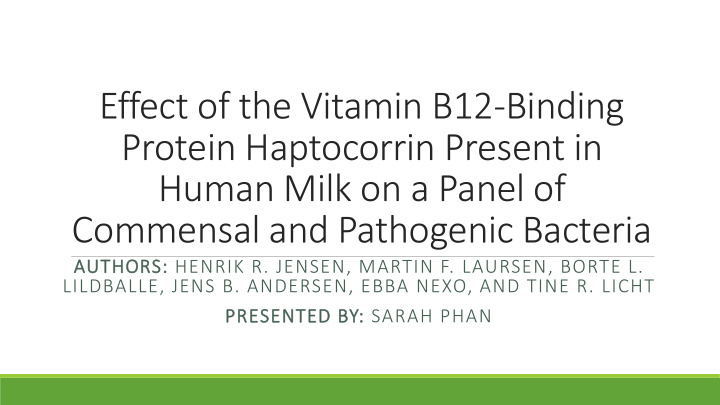



Effect of the Vitamin B12-Binding Protein Haptocorrin Present in Human Milk on a Panel of Commensal and Pathogenic Bacteria AUTHORS: HENRIK R. JENSEN, MARTIN F. LAURSEN, BORTE L. LILDBALLE, JENS B. ANDERSEN, EBBA NEXO, AND TINE R. LICHT PRESENTED BY: SARAH PHAN
Introduction: Haptocorrin is a glycoprotein, which is present in human milk in relatively large amounts Essential function is to bind and protect the acid-sensitive vitamin B12 while it moves through the stomach in adults While in infants, it has been proposed that haptocorrin contributes to the transport and absorption of vitamin B12 in infants while the gastric secretion of Intrinsic factor is not sufficiently developed Two forms: apo-hoptocorrin: unsaturated with vitamin B12 a much higher concentration in human milk, although unknown the reason why Holo-haptocorrin: saturated with vitamin B12 It is suggested that haptocorrin, exhibits antimicrobial effects in the intestine and thereby potentially protects the infant against pathogenic bacteria
Introduction: Hypothesis: That haptocorrin from human milk, by inhibiting the growth of certain bacteria and thereby favoring the growth of other bacteria, may influence the initial colonization in breastfed infants.
Methods: Haptocorrin: Four test samples of haptocorrin were collected: Human milk: Collected at Randers Hospital from donors Haptocorrin-free human milk: Prepared by affinity purification using antibodies targeting haptocorrin. The process removed >99.9% haptocorrin. Porcine holo-haptocorrin: Collected by purifying gastric extract of pigs Human apo-haptocorrin: Purified from a complete lactation from one donor, resulting in a solution of haptocorrin in which >97% of the enzyme was unsaturated. All haptocorrin samples were filter sterilized and stored at -20C before use.
Methods: Bacteria Strains: 34 strains were chosen with the criteria of: Being commensal in the stomach or intestine Being among the first colonizing bacteria in infants All bacteria were cultivated on their respective growth medium at 37C for 24 or 48 hours, as dictated by the bacteria strain.
Methods: Well-diffusion assay: Useful to screen for bacteria activity/growth The assay contained 20 agar plates, each mixed with one of three broth (MRS, BHI, or a specific Clostridium difficile liquid media), dependent on the bacteria strain being tested. Within each plate, a 7 mm in diameter well was made and added with either : 20 microliter of test sample (human milk, haptocorrin free human milk, porcine holo- haptocorrin, and human apo-haptocorrin) 20 micro gram/mL erythromycin (positive control for inhibition) Or 5 mM phosphate buffer pH 7 (negative control for inhibition) Only strains inhibited by human milk were further tested with haptocorrin-free human milk Plates were incubated in order to observe possible inhibition zones Inhibition zone of minimally 5 mm was defined as a positive inhibitory effect Assays were performed in triplicates
Results: Positive control (erythromycin) caused an inhibition zone around the wells Negative control (phosphate buffer) did not Effect of Human Milk With and Without Haptocorrin: Human milk increased bacteria density of: Bifidobacterium breve, B. bifidum, Lactobacillus acidophilus, L. johnsonii, Staphylococcus epidermidis, certain strains of E. coli, Salmonella Enteritidis, and S. Enteritidis Human milk inhibited growth of: S. thermophiles Pathogenic strains: L. monocytogens L028, L. monocytogens 4446, and L. monocytogens 7291 Haptocorrin-free human milk gave the same results of inhibition
Discussion/Conclusion: Inhibitory effect of human milk on S. thermophilus and the pathogenic strains L. monocytogenes LO28, L. monocytogenes 4446 and L. monocytogenes 7291 is likely to be attributed to lysozyme /lactoferrin/ immunoglobulin A or other antibacterial proteins in human milk Experiments with haptocorrin-free human milk revealed that the observed inhibitory effect of human milk on the mentioned bacteria was not caused by haptocorrin Similar inhibition zones were observed for haptocorrin-free human milk
Discussion/Conclusion : Human milk caused a higher density of certain bifidobacteria, lactobacilli, staphylococci, E. coli, and Salmonella strains around the wells Lactobacilli and E. coli can ferment lactose present in human milk Increased growth for two non-lactose fermenting Salmonella Enteritidis strains, which may be due to the oligosaccharide content in human milk
Discussion/Conclusion: No observable inhibitory effect of porcine holo- haptocorrin on any bacteria strains Unsaturated haptocorrin purified from human milk inhibited the growth of a single strain, B. breve Implies that the degree of saturation affects the inhibitory activity of haptocorrin on bacteria
Discussion/Conclusion: The results suggest that haptocorrin does not have a general antibacterial effect Therefore, it is unlikely that haptocorrin present in human milk through inhibitory properties alter the composition of the first colonizing bacteria in the intestine of breastfed infants.
Recommend
More recommend